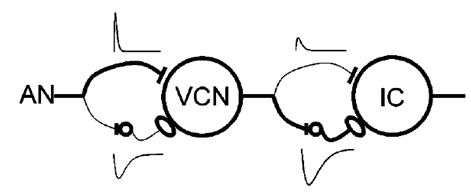Computational Models for Central Auditory Neurons
We have explored a number of computational models for neurons in the ascending auditory pathway, from the brainstem through the midbrain. Our current efforts are focused on modeling the responses of neurons in the inferior colliculus to a number of complex stimuli that have been used in recent physiological studies. Computational models can provide a more in depth understanding of physiological phenomena. Many different models have been developed for the different stages of the auditory pathway. Most previous models have been developed to describe the responses of inferior colliculus neruons to a specific stimulus paradigm.
Our ongoing work focuses on the development of a comprehensive model of the inferior colliculus that combines several of the modalities described in previous models. Our hypothesis is that a single model that is able to accurately describe the response of the inferior colliculus to a number of stimulus paradigms, such as forward masking, amplitude modulation, and mis-tuned harmonic paradigms, will be valuable in understanding the role of this brain region in processing of complex sounds.
 Schematic diagram of the same-frequency inhibition and excitation (SFIE) model. A single model AN fiber provides the postsynaptic cell with both excitatory and inhibitory input, via an inhibitory interneuron. The thickness of the lines corresponds to the relative strength of the inhibition and excitation at each level. Alpha functions representing the assumed membrane and synaptic properties are also shown.
Schematic diagram of the same-frequency inhibition and excitation (SFIE) model. A single model AN fiber provides the postsynaptic cell with both excitatory and inhibitory input, via an inhibitory interneuron. The thickness of the lines corresponds to the relative strength of the inhibition and excitation at each level. Alpha functions representing the assumed membrane and synaptic properties are also shown.
Researcher: Laurel H. Carney, Ph.D.
Auditory Neuroscience; neurophysiological, behavioral, and computational studies of hearing; signal processing for hearing aids.
